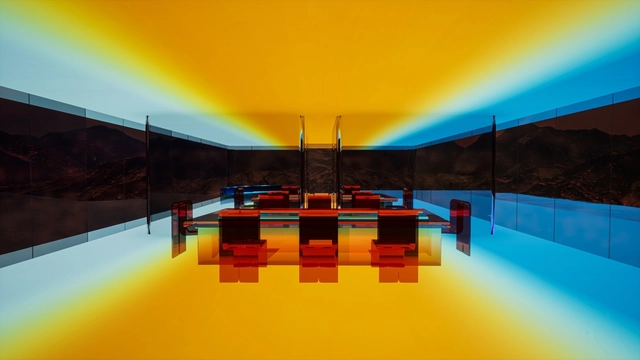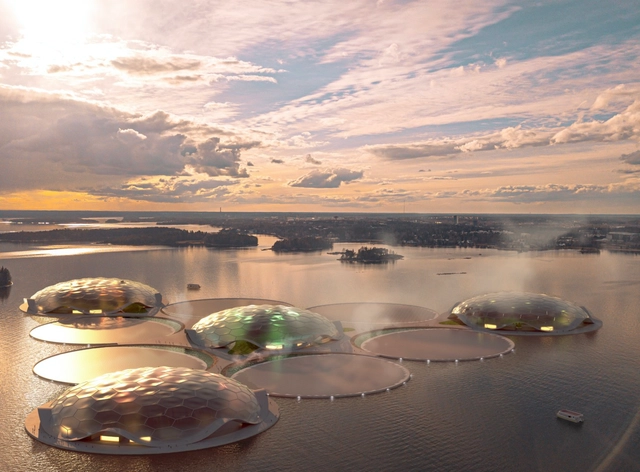A step-by-step outline on how to turn 3D models in SketchUp into 2D documentation through LayOut.
News
Generating Documentation With SketchUp
The Crypto-Future of Architecture: an Interview with Krista Kim

In preparation for the Disrupt Symposium, as the conference launch planned for the 1st of May approaches I sat down with Krista Kim a contemporary artist and founder of the Techism movement, whose work explores the concept of digital consciousness. Her interest in digital technology and it’s revolutionary effects on human perception, media, social structures, and communication have led her to work in both digital and physical realms.
Build a Resilient Firm by Identifying Opportunities of Remote Collaboration

All businesses, large or small, have faced unprecedented challenges in the last couple of years – but one of the positive outcomes of the global pandemic is the notion that work can be done wherever you are in the world. And while work has changed, expectations have not. Teams need to work with the same speed, efficiency and security as when they were all within the same four walls. It’s now up to IT to rise to this challenge with the right solutions to meet the new demands of the hybrid workforce. Remote working – and remote collaboration – is here to stay.
Deadline Extended: The ArchDaily Architectural Visualization Awards

Until this Tuesday, May 3rd at 23:59 EST you can submit your work for the second edition of the ArchDaily Architectural Visualization Awards. For us, visualizations have become a powerful tool that has helped us to think without limits about the design of our future cities, buildings, and structures. This is one of the reasons why we decided to launch this competition: to find the best talent from around the world and discover who is setting trends with their work and aesthetics, helping us to visualize the future of architecture.
First Look at the Architectural Installations of the 2022 Venice Art Biennale

The 59th International Art Exhibition - La Biennale di Venezia has officially opened its doors to the public on the 23rd of April, 2022. Titled "The Milk of Dreams”. the exhibition is welcoming more than 210 artists from 58 countries, to showcase over a thousand artworks and installations that promote art, science, research, and ecological transition from the environmental humanities.
SANAA-Designed Art Gallery of New South Wales to Open This December

The Art Gallery of New South Wales expansion designed by SANAA is set to open to the public on December 3rd, 2022. The project, dubbed Sydney Modern Project and first revealed in 2019, is the most significant cultural development in the city in almost five decades since the opening of the Sydney Opera house. The new building designed by SANAA, together with Australian practice Architectus as executive architect, features a series of pavilions of various sizes and gallery volumes cascading towards the harbour. The structure that opens toward its surroundings is designed to provide a backdrop for 21st-century art.
How Sasaki Is Shaping the Future of the World’s Higher Education Campuses

Over the past few years, educational campuses around the world have been confronted with various trends and challenges of change, such as pandemic adaptation, climate crisis, the responsibility for sustainable design and online teaching. Sasaki Architecture, with offices in Boston, Denver and Shanghai, specialises in planning educational campuses around the world. With a broad portfolio of projects at various scales of intervention, recent projects in the United States, China, Mexico and Peru stand out.
Transformation Generated by the Intersection of Virtual and Reality

As Antoine Picon describes in Architecture and the Virtual Towards a new Materiality? : "An architectural project is indeed a virtual object. It is all the more virtual that it anticipates not a single built realization but an entire range of them. …Whereas the architect used to manipulate static forms, he can now play with geometric flows. Surface and volumes topological deformations acquire a kind of evidence that traditional means of representation did not allow.”
Situationist Funhouse: Art’s Complicated Role in Redeveloping Cities

This article was originally published on Common Edge.
While Stephen Zacks’ new book, G.H. Hovagimyan: Situationist Funhouse, is ostensibly about the life and work of the artist, there’s an intriguing and seemingly topical subtext looming in the background: the role of art and culture on the development and redevelopment of cities. It’s a complicated and sometimes fraught issue, prone sometimes to simplistic, even binary thinking. Zacks, a friend and former colleague at Metropolis, has always had a more nuanced view of the issue. Last week I reached out to him to talk about the work of Hovagimyan, the historic lessons of 1970s New York, and why “gentrification” needs a new name.
Knowledge as a Disrupter in the Networked Practice of UNStudio

After the first years of launching their architectural practice, Ben van Berkel and Caroline Bos renamed their practice to UNStudio. Short for United Network Studio, the change of name stands symbolic to the knowledge based, networked nature of the firm, which has grown to expand to 6 offices worldwide today.
Business Development at Snøhetta: An Inside Look

Snøhetta was founded on the United Nations 1987 Brundtland Commission’s three main pillars of sustainable development: economic growth, environmental protection, and social equality. Their highly value and purpose-driven operations has since then expanded to 330 employees in 7 studios all over the world, from hometown Oslo to Adelaide, HongKong, Paris and Innsbrück, as well as their sister studios in New York and San Fransisco.
Allies and Morrison and Asif Khan Studio Selected to Design UK's Barbican Centre Refurbishment

A collaborative design team led by Allies and Morrison and Asif Khan Studio has been selected to renew the famed Barbican Centre in London, United Kingdom. The winning design proposal preserves the building’s original architectural language and provides new opportunities for the center's diverse community of artists, audiences, and partners, boosting the building’s accessibility and performance quality.
PVC 3D Panels: Creating Accent Walls in Interior Design Projects

Textures can calm us, bring warmth or even guide us. They elicit our sense of touch and also affect us visually. This is because lights and shadows tend to form in relation to the irregularities and shapes that are present in some textures, which can in turn clearly differentiate these types of materials from other surfaces. For many, the idea of a space surrounded with white, smooth walls can be disturbing and monotonous. Embellishments such as paints, the inclusion of natural coatings or other elements can easily transform a space, emphasizing certain parts or creating new and attractive visuals. In interior design projects, textured walls have always been a popular way to add prominence to a space, either via the constructive system of building - such as brick or exposed concrete walls - or through different types of coatings that can be added later on.
Balbek Bureau Develops Temporary Housing Scheme for Displaced Ukrainians

Since the beginning of the war, over 7.1 million people have been internally displaced within Ukraine. In response to this growing humanitarian crisis, Kyiv-based practice Balbek Bureau has developed a modular temporary housing system that aims to provide a dignified dwelling to internally displaced Ukrainians. RE:Ukraine is designed to adapt to different types of terrain and settlement density while being deployed in a short time frame. While the project was intended for areas of Ukraine that are not under fire, the framework can also accommodate refugees abroad.
The Power of Data: Exploring Architectural Language through the Use of Artificial Intelligence

The Power of Data is an exhibition created in a virtual building, conceived by three-dimensional geometries based on various artificial intelligence algorithms. The project was created by the OLA (Online Lab of Architecture) team of research architects formed by Jennifer Durand (Peru), Daniel Escobar (Colombia), Claudia Garcia (Spain), Giovanna Pillaca (Peru) and Jose Luis Vintimilla (Ecuador).
"Traditional Construction Is Doomed To Disappear:" Interview With the Portuguese Office Summary

Contemporary challenges and developments in technology inevitably trigger changes in the way we design and build our cities. SUMMARY, one of ArchDaily's Best New Practices of 2021, is a Portuguese architecture studio focused on the development of prefabricated and modular building systems. Striking a balance between pragmatism and experimentalism, the firm develops prefabricated solutions in order to respond to a driving challenge of contemporary architecture—to speed up and simplify the construction process. Founded in 2015 by the architect Samuel Gonçalves, a graduate of the School of Architecture of the University of Porto, the studio has presented at prominent events such as the 2016 Venice Biennale. We talked with Samuel about the firm's practical experience in prefabrication and modulation, as well as their experiments and forays into research.
Manhattan’s Center for Architecture Imagines the Future of Universal Design

How can Universal Design bridge the divides that have left many Americans stranded in their own communities? In its latest exhibition, Manhattan’s Center for Architecture calls for a “reset.” On view until September 3, Reset: Towards a New Commons, displays projects that “encourage new modes of living collaboratively” and “more holistic approaches to inclusion.”
On the Latest Representation Trends and Immersive Experiences in Virtual Design Platforms: SpaceForm x CRA

In 2021, CRA-Carlo Ratti Associati’s proposal to create sustainable alternatives for urban heating networks was selected as one of four winners of the global Helsinki Energy Challenge. The project entitled Hot Heart proposed “island-like, floating seawater reservoirs to heat the city of Helsinki in a green way”. Using Twinmotion, Epic Games’ real-time visualization platform for the architecture industry to design the intervention, the large scale infrastructural project needed a digital representation tool to possibly put scale into perspective, offer a real immersive experience to engage the client, and exhibit instant changes related to natural factors such as daylight. Come SpaceForm, a data-driven virtual presentation and design tool. Created to facilitate remote cooperation, the technology allows clients or stakeholders to be more immersed in the story of the design.
Climate-Smart Furniture: The Story Behind a 100% Sustainable Lounge Chair

Since the early 2000s, it has been widely reported that the construction industry accounts for nearly 40% of the planet’s CO2 emissions. The role of interiors in that percentage has been historically underestimated, with common statistics suggesting that a project’s furniture, fixtures and equipment are only responsible for about 7 to 10% of its overall carbon footprint. However, new research notably indicates the contrary: in a building’s average life span, the carbon footprint of its interiors will equal – if not exceed – that of the structure and envelope. Interior design, to the surprise of many, has actually been doing great harm.
Japan's Tallest Building by Pelli Clarke & Partners Tops Out

Pelli Clarke & Partners' A District tower, a 330-meter mixed-use high-rise in central Tokyo, has finally topped out to become the tallest building in the country. The tower is part of the Tora Asa urban village, which aims to "forge a city within the city" and revitalize Tokyo's city center. A District Tower will feature large-scale office spaces, residences, a school, a medical center, and retail facilities, along with vast green spaces on the ground floor.
UN-Habitat and Oceanix Reveal Prototype for the World's First Sustainable Floating City

UN-Habitat and blue tech firm OCEANIX unveiled the design of the world’s first prototype for a sustainable floating city, to be hosted by Busan. The project is intended to provide a scalable framework of development for coastal cities facing land shortages and rising sea levels. With a population of 3.4 million people, Busan is the second-largest city in the Republic of Korea and, at the same time, one of the most important maritime cities, making it a suitable environment for deploying the floating city prototype.
























.jpg?1651131882)
.jpg?1651131879)
.jpg?1651131774)










































